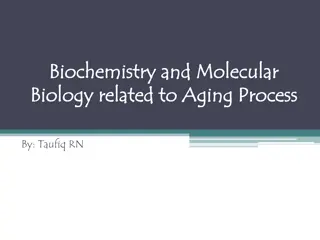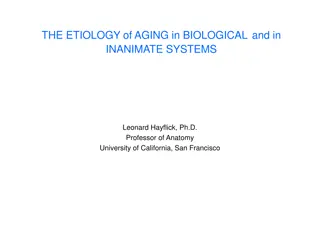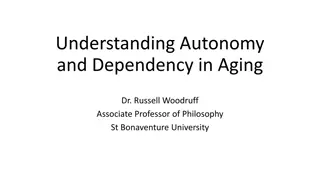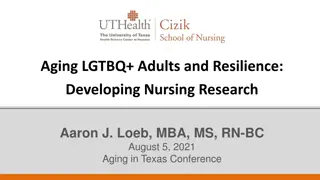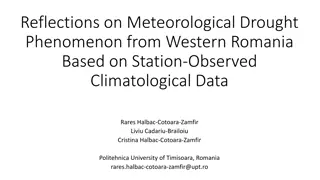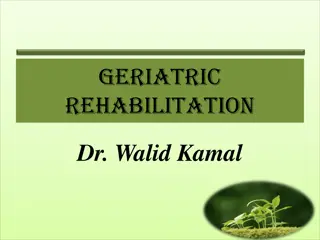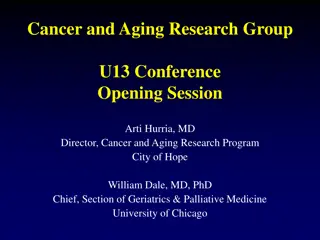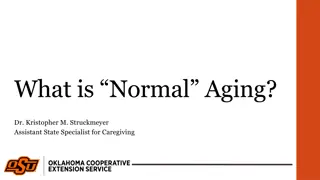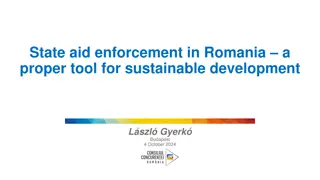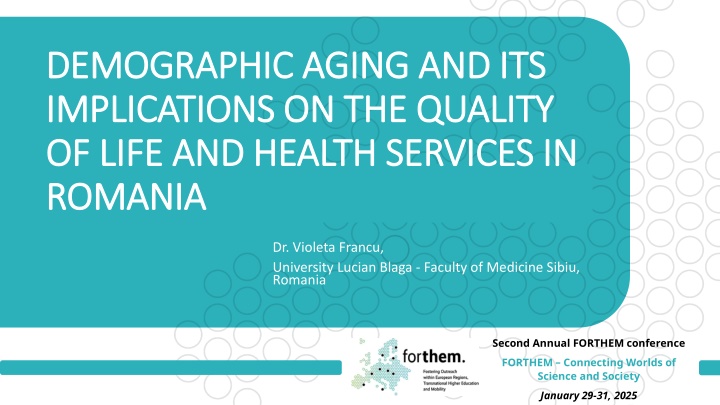
Demographic Aging and Quality of Life in Romania
Implications of demographic aging on the quality of life and health services in Romania due to factors like emigration, declining birth rates, and aging population. This trend poses challenges for economies, health systems, and social structures, impacting labor force, healthcare services, pension systems, and government spending.
Download Presentation

Please find below an Image/Link to download the presentation.
The content on the website is provided AS IS for your information and personal use only. It may not be sold, licensed, or shared on other websites without obtaining consent from the author. If you encounter any issues during the download, it is possible that the publisher has removed the file from their server.
You are allowed to download the files provided on this website for personal or commercial use, subject to the condition that they are used lawfully. All files are the property of their respective owners.
The content on the website is provided AS IS for your information and personal use only. It may not be sold, licensed, or shared on other websites without obtaining consent from the author.
E N D
Presentation Transcript
D DEMOGRAPHIC AGING AND ITS EMOGRAPHIC AGING AND ITS IMPLICATIONS ON THE QUALITY IMPLICATIONS ON THE QUALITY OF LIFE AND HEALTH SERVICES IN OF LIFE AND HEALTH SERVICES IN ROMANIA ROMANIA Dr. Violeta Francu, University Lucian Blaga - Faculty of Medicine Sibiu, Romania Second Annual FORTHEM conference FORTHEM Connecting Worlds of Science and Society January 29-31, 2025
AGING POPULATION AGING POPULATION - - A PUBLIC HEALTH PROBLEM A PUBLIC HEALTH PROBLEM The ageing of Europe, also known as the greying of Europe, is a demographic phenomenon characterised by a decrease in fertility, a decrease in mortality rate, and a higher life expectancy among European population. In Romania we also have an important increase in emigration and a decrease in natality. Romania is among the top 20 countries in the world in the ranking of countries with the highest emigration, with over 4 million Romanians living outside the country, according to the Global Migration Report, 2022. Second Annual FORTHEM conference FORTHEM Connecting Worlds of Science and Society January 29-31, 2025
The consequence is the increase in the proportion of elderly people in the total population. This trend has major implications for the economies, health systems and social structures of European countries: Impact on the economy - Labor force decline: an aging population leads to a decrease in the available labor force, which can reduce economic productivity - Declining consumption: older people tend to consume less than the younger population, which can negatively affect certain economic sectors. - The need to adapt the labor market and the economy: increased demand for services and products for the elderly (home care, adapted housing, etc.).
Impact on health systems - Older people require more health services, including treatments for chronic diseases, long-term care, and disability support.This leads to increased government spending on health and the need to expand medical infrastructure. Pressure on pension and social assistance systems - The number of active taxpayers (young population) decreases in relation to that of pension beneficiaries. - Social assistance systems are becoming more expensive, requiring additional funding to support the care of the elderly. - Governments are forced to reform pension systems, encourage birth rates, or attract immigrants to counterbalance the decline in the working population.
In 2019, people aged 55 years or more accounted for just over one third (33.6 %) of the total EU-27 population (Figure 1). This share was higher than one third, in 10 of the EU Member States and peaked at 36.5 % in Italy. At the other end of the range, people aged 55 years or more accounted for one quarter (25.0 %) of the population in Ireland (the youngest pop. in Europe). The share of this age group (55 years or more) in the EU-27 population is projected to reach 40.6 % by 2050; - 45.9 % of the population in Italy, and - for more than 45 % in Lithuania, Portugal, Greece and Latvia. Second Annual FORTHEM conference FORTHEM Connecting Worlds of Science and Society January 29-31, 2025
The influence of population aging on quality of life The influence of population aging on quality of life Increased risk of social isolation older people may become more vulnerable to loneliness and depression due to loss of loved ones, reduced mobility or reduced participation in active life. Improving the quality of life depends on the integration of the elderly into the community, through social and cultural initiatives. Financial barriers Many retirees face insufficient pensions, which affects their access to services, medicines and other essential goods. Increased care needs Increased support is needed for older people, especially those with chronic illnesses or disabilities. Maintaining and caring for the elderly can put pressure on families and public systems Managing this phenomenon requires collaboration between governments, communities and families to create a more age-friendly and supportive environment for older people. Second Annual FORTHEM conference FORTHEM Connecting Worlds of Science and Society January 29-31, 2025
The impact of population aging on health systems The impact of population aging on health systems Increased demand for health services Elderly people frequently use health services, including consultations, hospitalizations and treatments for chronic diseases such as diabetes, cardiovascular diseases,cancer, Alzheimer s etc. Accessibility barriers Not all older people have equal access to care services, which can negatively affect quality of life. Insufficiency of human resources The lack of doctors, nurses and staff specialized in geriatrics affects the quality of the care provided. High costs of health services and care Treatments for age-related conditions, such as cancer or degenerative diseases, involve substantial expenditure, with the pressure being felt by both the public budget and patients. Need for long-term care services Nursing homes, day care centers and home care services are underdeveloped to meet the demand. Second Annual FORTHEM conference FORTHEM Connecting Worlds of Science and Society January 29-31, 2025
Challenges and solutions Challenges and solutions Development of community services: access to support services and home care can help reduce isolation and improve the lives of older people. A sustainable pension system: a reform of the pension system could support the elderly to maintain a decent quality of life Investments in health infrastructure: building and modernizing hospitals, as well as developing geriatric centers, are essential. Training of medical personnel: it is necessary to increase the number of geriatric specialists and their training to respond to the specific requirements of the elderly. Prevention programs: promoting a healthy lifestyle and implementing prevention programs can help reduce the incidence of chronic diseases. Second Annual FORTHEM conference FORTHEM Connecting Worlds of Science and Society January 29-31, 2025
Demographic aging is an inevitable process, but through appropriate public policies and an integrated approach, the negative impact on quality of life and health services can be minimized. Thank you! Thank you! Second Annual FORTHEM conference FORTHEM Connecting Worlds of Science and Society January 29-31, 2025





